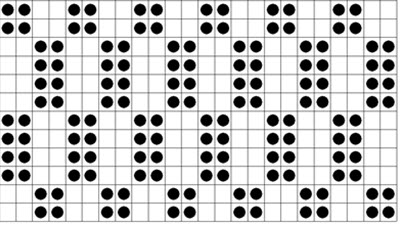..........So we're gonna talk today.....about stitch patterning...........You know, most knitters,..........and again, I was talking to a new knitter.....the other day, and the first thing they..........want to do is start.....doing stitch patterning...........And it's like I just want to say, slow.....down, slow down, slow down, slow down...........Master your machine first...........Get it set up, figure out what.....kind of yarn you're going to use...........Figure out what kind of yarn.....works well for your machine...........Learn about the buttons and levers on your.....machine, get familiar with your manual...........All of that good stuff,.....and then tackle stitch patterning...........So I'm going to assume that you're.....to that point. You've either played..........with stitch patterning or.....you are ready to do that...........And what I want to do is encourage you.....to look and learn about stitch patterns...........But the idea is that you can take a card.....and I'm talking punch cards here...........But this applies to electronic.....machines as well...........You can take a card,.....a stitch design and use it in a whole..........bunch of different ways,.....without repenting the card...........So we're going to talk in general, just.....kind of an overview of stitch patterns...........I'll keep pointing to cards...........But please understand that I'm talking..........electronics or even hand manipulated.....stitch patterns and some of the different..........options that you have using just.....one card. Using that same card...........So what can you do with stitch patterns?..........Let's start first with what.....is stitch patterning?..........Automatic stitch patterning..........refers to your knitting machine.....selecting needles for you...........So no matter what stitch pattern you want..........to use, which technique, be it Fairisle or.....slip or tuck or knitweave or lace...........The way a machine works is that certain.....needles are selected,..........put into a specific position,.....and then the carriage interprets..........your choices...........Your choices of which needles.....are being selected...........Your carriage interprets that and either..........feeds yarns in a certain way or feeds.....a single yarn in a certain way...........It either knits stitches or doesn't knit.....stitches, maybe slips them or tucks them...........Automatic patterning just has.....to do with selecting needles...........Now, of course, on a manual machine...........You can select your own needles and do..........many, many of the things.....that we'll talk about here today...........But I think the focus here is more.....automatic patterning machines...........So a knitting machine,.....and automatic patterning...........The first thing you have to do is tell..........the machine that you.....want to work in pattern...........So all the machines are.....a little bit different...........You push a button, you switch a lever,.....you do something and you say, hey,..........I want to knit in something.....other than stockinette...........Wake up......Hello, wake up...........And this is what I want it to look like...........So I give the machine some sort.....of instruction, whether it's with a card..........or with electronics. It's hole / no hole on /.....off, black/white machines are very, very .............Binary...........I think that's the word.....they're either on or off...........Right......So the machine now knows...........Okay, she wants to knit in pattern...........Once we tell it,..........we want to knit in pattern,.....we give it the instructions electronically..........or this way, mechanically,.....one or the other...........We then tell our carriage somehow,.....no matter what,..........depending on what carriage,.....you have, to choose the needles, to work..........with the needles that are.....selected and deselected...........They're in working position,.....or they're in middle position...........So you've got buttons and levers, and all.....the carriages are a little bit different...........But the key is that you are telling..........the machine to select some.....needles, and so it does...........And then by moving any buttons and levers.....and things on your carriage,..........you are directing where the butts.....of those needles are going to go...........And depending on how those butts..........of the needles are positioned as you.....take the carriage across in conjection,..........along with the selection of what type.....of stitch pattern you want to use...........So there's like, three big,.....major components...........You tell the machine you wanted to knit in pattern,..........you tell the carriage you want to.....look at those needles positions...........And then the third thing is you tell.....the carriage which type of stitch pattern..........you want to do, be it tuck or.....slip or Fairisle whatever...........Now, if you're brand new to this whole..........world, we do have a course,.....and it is called Automatic Patterning...........I'll put a link to it in the show notes,.....and it takes you...........My goal is for you.....to understand these concepts...........Not necessarily say, okay...........I need to push the part button,.....and it's okay to have a cheat sheet...........However, I want you to understand how.....automatic patterning works on your machine..........so that when you go to a different.....machine, which come on,..........most of us have more than one machine,.....or you get a new machine...........The learning curve for that new.....machine will be less...........And you will understand what's going.....on and not be in the dark because you just..........did the five steps.....that your manual said...........I want you to understand......Okay...........I'm going to get off.....my soapbox about that...........And we're going to move on......

